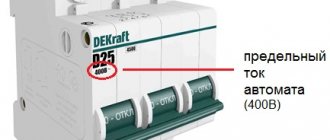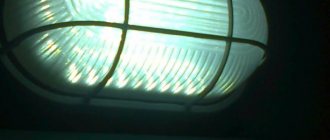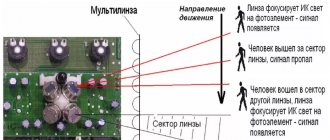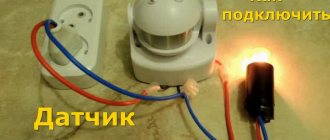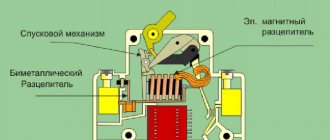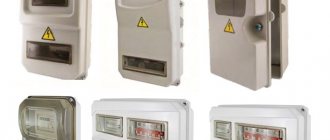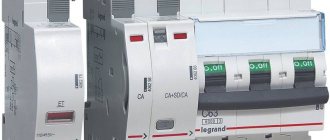Principle of operation
Switch with motion sensor
The motion switch provides automatic switching on and off of lighting devices, focusing on certain environmental disturbances. The light turns on when movements of living organisms are detected within the spatial limits of the detector's susceptibility. Models are available designed for various types of waves: infrared, ultrasound, microwave. This allows you to choose a product that suits the consumer’s goals and the conditions in which it is planned to be used.
According to the method of detecting the appearance of a person in the receptivity zone of a motion sensor (MS), switches are classified into active and passive. The former themselves emit waves and monitor the nature of their reflection. Triggering occurs when the distances traveled by the pulse from the sensor to the obstacle and back are not identical - this indicates that the obstacle is a moving object. Such mechanisms work with radio waves or ultrasound. The latter, although not perceptible to the human ear, causes a lot of anxiety for pets, so pet owners are not recommended to choose such products.
Passive sensors do not emit waves, but only capture thermal impulses from a living organism of sufficient weight. They are more affordable in price and simpler in design than active ones, but when used, the likelihood of an erroneous operation is higher.
There are mixed type DDs that integrate the mechanisms of active and passive devices.
Choosing the optimal installation location
If the key switch comes with the sensor in the same housing, then it is designed for wall mounting. However, if the sensors are supplied in a disassembled kit or purchased separately, then they can be installed not only on the wall, but also on the ceiling. Moreover, the ceiling option is often preferable, since it covers a large area.
The installation location directly depends on the viewing angle indicated in the data sheet for which the motion sensor for the light switch is designed
Each sensor device has its own viewing angle ranging from 10 to 360 degrees. If it has this parameter less than 360°, then the sensor will be able to track movements only in a narrow observation sector. In this case, you will have to install several tracking devices in the room so that they cover all the required space.
Wide-angle and circular detectors are more expensive than those designed for a small coverage angle. However, too many of the latter may be required to completely control the room. Here it is important to carefully weigh and calculate everything before going to the store for consumables.
If the switch is installed in a small room with one door, then installing a sensor with a narrow viewing sector will be enough. You just need to point it precisely at the entrance and set the maximum possible time for turning on the light in the settings.
Another point is that the motion detector has a “dead zone” in height. During installation, you must carefully study the passport in order to correctly set the direction of operation of the sensor.
Plus there are still restrictions on the range of the detection zone. For verandas or long corridors, it is recommended to choose long-range devices. However, remember that with a large area of control, they may begin to work too often at the wrong time.
Types of motion sensors
Motion sensor switches can operate with different types of wave radiation. This causes differences in the preferred conditions for using the devices. In addition, they also differ in such parameters as the size of the working area, signal transmission distance, the number of simultaneously operating lighting devices, and viewing angle.
Overview of sensor types
They differ from each other in the nuances of application and the accuracy of the result. The following types of sensors are distinguished:
- Infrared - react to thermal radiation emitted by humans and warm-blooded animals, which is why false inclusions are possible, especially in the case of large dogs. They have an affordable price and a large working area radius.
- Acoustic - react to sound: the creaking of a door, the clicking of heels, the clapping of hands. Like the previous type, they belong to the class of passive devices. Since sound vibrations arising in the field can have different origins, the scope of application of devices of this group is very limited: they are suitable for the basements of private houses, where the source of sound is always the approaching owner. Also, such a switch can be connected in the corridor of a public building.
- Generating microwave radiation and tracking the movement of waves. When a moving object appears, the contacts close or open. Particularly sensitive models are able to recognize an approach even from behind an obstacle, which is why they are often used in security systems.
- Emitting ultrasound. The principle of operation is similar to the previous type, only the nature of the radiation differs. In apartments and private households where there are animals, such devices should not be used.
Infrared
Acoustic Microwave
Ultrasonic
To improve the accuracy of signal reading, different types of detectors can be built into the sensor. Such models are more expensive, but more accurate in operation, have a low percentage of false positives and flexible configuration options.
Product range
A motion sensor for turning on lighting in a house is a special device that is classified as a detection device. The light turned on by such a sensor when a certain object enters its operating area. In this case, the object is fixed and a signal is transmitted to the device, which turns on the light. Such equipment has a certain degree of sensitivity to the level of illumination in the house.
Note! You can connect not only any lighting device to such a product, but also sound equipment, alarm systems, etc.
Today there is a fairly large assortment of similar devices on the market that can respond to movement and turn on the light in the room. Such devices can be completely camouflaged in the general interior of the room or be visible. It all depends on your desire.
From the available range of sensors, the following models can be distinguished, which are divided by:
- installation location;
- type of alarm.
In addition, sensors can be internal or external. Internal ones are installed in residential premises, but external ones are installed on the street.
Please note! The internal sensor cannot withstand prolonged exposure to low temperatures. As a result, it breaks down and will not be able to adequately perform its direct functions.
Also, all these devices can be divided into the following models:
- ultrasonic. The principle of their operation is based on the reflection of ultrasonic waves from objects. It is the simplest, most affordable and durable sensor available on the market today;
Ultrasonic model
- infrared. Their principle is similar to a very sensitive thermometer. It reacts when waves of a certain temperature enter its operating zone. Only in this case will he turn on the light. For example, the device can be set to a temperature of 36.6 degrees. This eliminates the possibility of the device being activated by pets;
Note! Infrared models should not be placed near doors or in the kitchen. Most often they are installed in living rooms.
Infrared model
- microwave. The operating principle of such devices is the same as that of locators. Inside, the sensor is equipped with a locator that sends signals within a given range at certain intervals. If they are detected, the device is activated and turns on the light. It is considered the more practical of these three models, but costs an order of magnitude more.
Microwave model
Which model is better to buy, everyone must decide for themselves, based on their own needs.
Connection diagrams
The simplest scheme involves connecting the DD to the break in the phase cable going to the light bulb (LED, fluorescent or simple). This option is suitable for a room without windows. Otherwise, it will be necessary to install a device simultaneously with the DD that prevents the lights from being turned on during the daytime. This may be a photo relay operating in automatic mode, or a user-controlled switch.
Both of these devices are installed in the same wire break. In this case, the photo relay is placed in front of the DD - then it will receive electricity only in the dark, and the structure will not function idle. This scheme will extend the service life of the DD: they are all created with a limited number of operations in mind.
What are the benefits of sensors?
Since buying a device that reacts to movement to turn on the light is not the cheapest pleasure, it is necessary to clearly understand not only the advantages of such a purchase, but also its purpose.
According to their purpose, such devices are designed to automate the process of turning on light in a room.
But besides this, they simultaneously relieve the load on the electrical network by turning off the lights when there are no people in the room. The principle of economy is based on this. As a result, the service life of the lamps and the lighting fixtures themselves increases.
Therefore, such products are most often used in the following situations:
- control of the level of illumination in residential premises or on the street;
- lighting of stairwells and corridors;
- control over the level of light in warehouses and other similar premises.
In addition, the installation of such products is relevant in those rooms where there are specific requirements (for example, for sterility).
Also, such devices can be easily used as security alarm systems.
The main purpose of this kind of sensors is to save money and time, as well as create comfortable conditions for work and rest.
Basic installation diagrams
Usually, the sensor comes with instructions that describe how to install it and is equipped with a connection diagram. In general terms, the installation looks like this:
- the sensor is placed in the wire gap;
- into the terminals marked with the letters L (phase) and N (zero), the cores of the supporting wires are connected;
- the output from the third terminal leads to the lamp.
If automatic detection is not enough and the user wants to implement a manual lighting control method, there are two ways to do this. In the first case, the switch is mounted in a phase wire extending to the DD from the panel - then in the open state the device does not read signals and does not supply voltage to the lamp. In the second, the key is placed in a line running from the phase to the input of the light bulb, and then when closed, the light will remain on, even if the DD does not work.
If it is necessary to install more than one sensor, they are connected in parallel, with wires from each sensor going to the input of the lamp, and the lighting is turned on if any of them is triggered. Another option is to purchase lamps with DD mounted in the housing.
Energy-saving lamps tend to quickly fail when frequently turned on and off from the network, so without a special protection unit you should not use them for a network with DD - the saving effect will be reduced to zero.
The block is placed in front of the lamp after the DD. It ensures leveling of voltage drops in the network, which is why the light bulbs will not burn out so quickly.
Components and operation
The switches in question differ from ordinary ones, although they may also have off keys. The gadget is equipped with an integrated motion sensor, a corresponding contact closing/opening relay, and setting elements (timer, potentiometer). If the device is of an advanced design, there are several control elements on its body. A mandatory part is a lens or window for the sensor.
Such switches, like conventional models, are also equipped with elements for manually turning on/off lighting: keys, buttons, switches and are almost no different from them in appearance. The only difference is the presence in the center of the sensor lens and several control elements (toggle switches, regulators). Other devices consist of two parts. The first is a block with blocks for connecting cables (distribution box). The second with a rotating leg contains the sensor itself and is attached to the wall.
For ease of use of the device, its design provides for setting certain parameters. The user adjusts the sensitivity, lighting power, and sets the interval to respond to changes in the environment.
Sensitivity
Sensitivity is adjusted experimentally, testing the device's response to moving objects with various parameters. This is necessary so that the gadget does not react to everything: birds, insects, movement of tree branches.
Responses to ambient light intensity
The option to configure the response to the intensity of ambient light and lamp power provides for the device to be used only at the desired time of day with a given light intensity. This parameter is set using a potentiometer or similar unit included in the switch.
Timer
The timer is an essential part of the device. It is used to record the time during which the lamp shines after the sensor reacts and in the absence of movement of objects. The optimal value is 1–2 minutes, however, the user can set any period depending on the configuration capabilities of the product.
In addition to the sensitive infrared element, some models of gadgets have a photocell that reacts to the degree of illumination. This makes it possible to automatically turn on the light when it gets dark or at a certain light intensity. There are samples with an additional acoustic sensor that responds to sound (clap of hands, voice).
Connection setup
To optimize the functioning, the switch with DD must be configured correctly. Calibration is necessary for three indicators - shutdown delay time, susceptibility and illumination.
Setting by time
The duration of the delay is a highly variable parameter: for some models it is 3 seconds, for others the maximum possible value reaches 10-15 minutes. The knob itself is usually listed as “Time”. Calibration can be done as follows: having set the desired value, wait until the light turns off. If the time interval seems too long or short, adjust it as needed.
Illumination level
Its regulator is only available on models with a built-in photo relay. He signs himself as “Lux”. When making a connection, the sensor is set to the maximum value, and when it starts to get dark, it is reduced until the light comes on.
Sensitivity Setting
The parameter is designated “Sen”. It determines the frequency of false activations associated with pet movements. Owners of large dogs will not be able to avoid such alarms, but for smaller animals it is possible. Calibration begins by setting the minimum value and testing on yourself and on the animal. The indicator is added as needed.
Place and conditions for connection
Switches with a motion detection function are installed instead of standard devices. However, there are a number of features regarding the operation of devices that respond to infrared radiation. It is necessary to position the device so as not to create discomfort for the occupants of the room due to frequent false alarms of the sensor. For example, you should not place the device too close to the corridor. If such an error is made, the light in the room will turn on every time a person passes along the corridor.
If the device is located outdoors or in a damp room, it must be protected from external influences. The level of protection is indicated by the product marking. For example, IP44 means that the switch has the fourth class of protection against dust and the same class of protection against moisture.
If small-power lighting devices are used in the room (for example, 15-watt LED light bulbs), then it is better to purchase not a two-wire, but a three-wire switch. This device is specially designed to work with low-power equipment.
Devices that respond to movement must be installed exclusively within the visible area. The reduction in range is affected by all sorts of obstacles encountered in the signal path (eaves, suspended structures, glass, etc.). You cannot install sensors near heating radiators, large household appliances, or devices that emit electromagnetic waves. It is recommended to use sensors with a power reserve (15 - 20%) - this will help insure against signal insufficiency.
The power rating of the device is in the range of 500 – 1000 Watts. If the device, in addition to movement, also reacts to the light level, it must be installed in a place where changing light intensity will not cause false alarms.
Device selection
To choose the right switch model with DD, the user needs to take into account the limitations imposed by different types of devices. The operating conditions of the device must also be taken into account.
Buying Tips
IR sensors are often used in kitchen switches and other devices designed for use strictly inside the home. They are also suitable for street lighting, but for corridors and stairs it is better to choose other options that are less prone to false positives.
When installing a switch, you need to think about its location so that direct rays of the sun and radiation from lighting devices do not fall on it, otherwise it will quickly fail. For flexible lighting settings, you need to choose a model equipped with a built-in photo relay.
You need to pay attention to the power of the load connected to the device. If the total power of the light bulbs exceeds that of the sensor, the load will have to be divided between two DDs.
Use in the toilet
It is worth highlighting the use of a sensor to detect the presence of a person in a room such as a toilet. This is due, first of all, to the fact that the switch is often installed outside the space of a given room. Also, using this device here will provide not only convenience and comfort, but will also significantly reduce the cost of electrical energy, since the risk of leaving the light on will disappear.
For a toilet, the most suitable option is an infrared sensor to detect movement. The main advantages of such a device include its fairly small size, the possibility of precise settings, reasonable cost and absolute safety for others.
